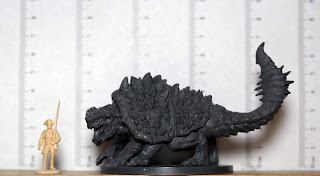There was that time upon the river of Rhone, in a certain wood between Aries and Avignon, a great dragon, half beast and half fish, greater than an ox, longer than an horse, having teeth sharp as a sword, and horned on either side, head like a lion, tail like a serpent, and defended him with two wings on either side... He came thither by sea from Galicia, and was engendered of Leviathan, which is a serpent of the water and is much wood, and of a beast called Bonacho, that is engendered in Galicia.
– The Golden Legend
In legend, the Tarasque is a dragon-like creature tamed by Martha of Bethany, and killed by the townsfolk of Nerluc after it was rendered docile. The locals were subsequently converted to Christianity by Martha, and renamed the town Tarascon in remembrance of the slain dragon.
In the 15th century, a festival incorporating an effigy of the Tarasque was celebrated to retell the tale of Martha and the dragon, and to exorcise the dragon's influence which was blamed for flooding in the region.
 |
| Tarasque effigy flanked by Tarascaires |
A similar dragon effigy is used in Corpus Christi festivals in Spain, though the roles of Martha and the dragon seem to be somehow conflated, with the title La Tarasca being commonly used to refer to the female figure riding atop the dragon.
 |
| The age-old question... |
The appearance of the Tarasque seems to have varied a bit, but the most common form showed a creature with six legs, a turtle-like shell, and a leonine face. A pair of feet usually are shown dangling out of its mouth.
Other paintings of the Tarasque show it as a regular dragon, albeit with the usual pair of feet sticking out of its mouth.
Very few depictions of the Tarasque show it as having wings, despite being mentioned in the legend.
 |
| St. Martha Tramples the Dragon |
One image shows the Tarasque looking similar to how whales were portrayed at the time.
 |
| German whales |
The D&D version of the monster is the Tarrasque, but it is only loosely based on the mythological beast, being vastly larger and with only four limbs.
In later editions, the Tarrasque lost the turtle-like shell and became more dinosaur-like.
In fact, the design reminds me a lot of American Godzilla.
Most miniatures of the Tarasque tend to be colossal as far as size goes, but I was interested in getting something a little more modest in size, and hopefully more faithful in appearance to the mythological creature.
The only model that was close in size to what I wanted comes from Time of Legends: Joan of Arc by Mythic Games. I didn't back their Kickstarter campaign because their miniatures were 15mm, but they do have some very nice sculpts.
The Mythic Tarasque resembles an ankylosaurus or glyptodont, with a paddle-like tail similar to a sea scorpion, and a shark-like head. It is not modeled after any existing depiction of the Tarasque, but it does have six legs and a shell.















































